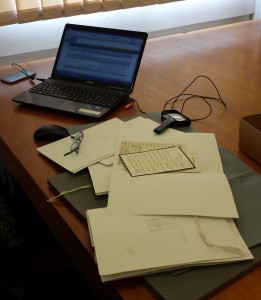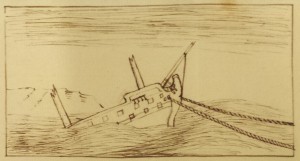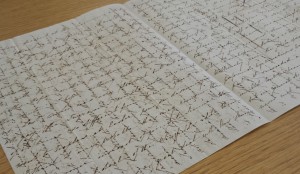
June 1, 2016, by Kathryn Steenson
Et Maintenant Quelque Chose De Différent
Guest post by Jan Perrett MBE, volunteer at Manuscripts & Special Collections and former Deputy Director of the Careers and Employability Service at The University of Nottingham, to mark Volunteers’ Week 2016.
After working for over 20 years at the University Careers and Employability Service, I decided to put more flexibility into my lifestyle by becoming self-employed. This meant I had some ‘free’ time in the week so I decided to volunteer at the university as a way of giving back but also of keeping a connection with my former workplace.
I approached Manuscripts and Special Collections to see what might be available and filled in the application form. In the Skills section I was foolish (or brave) enough to list my French language education. This detail was picked up by the eagle-eyed archivists, who recognised an opportunity to catalogue some of their large collection of letters in French.
Now you might think that transcribing such letters would be a doddle for someone with several degrees in French, but what they don’t tell you before you start is that a) these are written by English people b) that these English people have often a rudimentary grasp of the French language, grammar and spelling and c) that their handwriting is appalling! All of which became apparent at my first session when I quickly recognised the need for reading glasses, good light, a magnifying glass and an ability to judge the meaning of a badly-spelt French word from the context.
So far, I have worked on the Galway collection, the Bentinck collection and also translated the text on some amazing French etchings. The Bentinck collection was very interesting, as this is a naval family and many of the letters were written during the Seven Years’ War by John Bentinck from on board his various ships, describing naval skirmishes and some notable victories. I learnt a great deal of naval vocabulary.
I also transcribe English letters from the Galway collection and I regularly find myself researching notable events of the 19th C in order to fully understand the context and meaning of the text. For me, this aspect of research adds richness to the transcribing; I feel that my transcriptions are more ‘reader-friendly’ if I can convey some of the nuances of the period.
It is worth mentioning that the dreadful handwriting is not restricted to the French correspondence. Some of the Galway letters are virtually illegible and this can be due to a number of factors including very ‘loopy’ writing style, faded ink, thin paper and (as below) the habit of writing crossways on top of other writing.
I love my Friday afternoons at KMC and I would certainly encourage others to consider volunteering at the university not only as a benefit to the institution, but also as a way of broadening horizons and knowledge and just doing something completely different.
If you’d like to view the letters from these collections, or any of our archives and rare books, please contact us to make an appointment. For more information about our holdings, please visit our website. You can also follow us on Twitter @mssUniNott or read our newsletter, Discover.
Volunteers’ Week (1 – 12 June 2016) is a national celebration recognising the invaluable contribution that the UK’S 21 million volunteers make. Thank you to everyone who volunteers at Manuscripts & Special Collections for their help in cleaning, listing and translating documents.
No comments yet, fill out a comment to be the first





Leave a Reply